The OnePlus 3T Review
by Brandon Chester on November 28, 2016 10:30 AM EST- Posted in
- Smartphones
- OnePlus
- OnePlus 3T
GPU Performance
Along with the 10% increase in peak CPU clock speeds, the version of Snapdragon 821 in the OnePlus 3T also increases the peak GPU frequency to 653MHz, up from 624MHz in the OnePlus 3. This is a relatively modest improvement, so the corresponding increase in performance will also be rather modest as well. In the interest of merely verifying that performance has improved as expected, I've run 3DMark Sling Shot and GFXBench Car Chase on the OnePlus 3T.
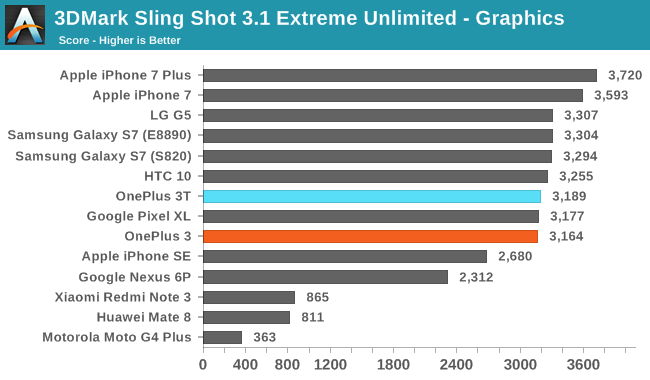

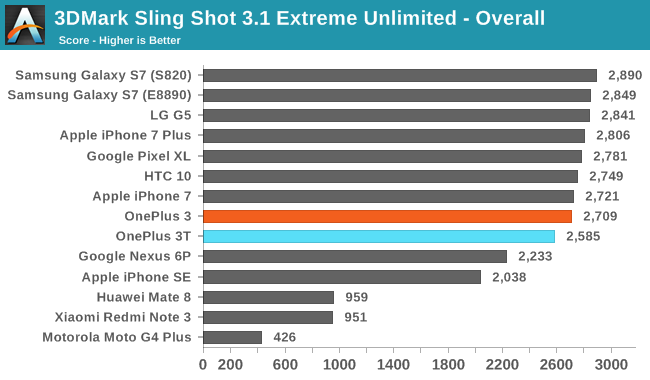
The 3DMark graphics test actually doesn't see much of an improvement on the OnePlus 3T. It may be that I simply got an exceptionally good score on the OnePlus 3, but it is interesting to see such a large gap in the physics test, which should favor the OnePlus 3T with its higher-clocked CPU cores.
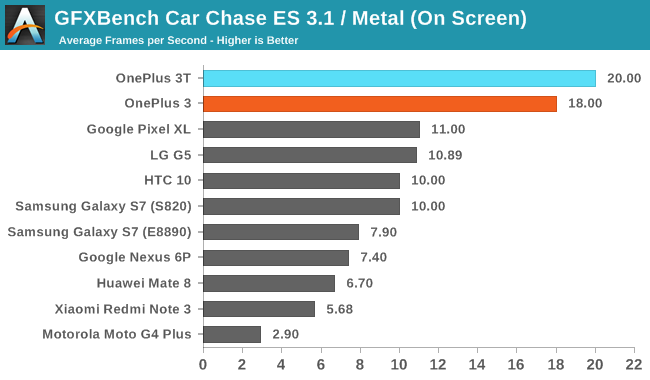

In GFXBench Car Chase the OnePlus 3T shows a performance uplift of around 10% compared to the OnePlus 3. This is slightly higher than expected, but due to the truncation of results in the latest GFXBench this may be slightly exaggerated, which tends to happen when comparing devices that differ in performance by only one or two frames per second.
NAND Performance
In our recent review of the Pixel XL one of the problems we ran into was that AndroBench had been broken by the adoption of file-based encryption (FBE) in Android Nougat. AndroBench is the benchmark we use to measure storage performance, and since that time it has been updated with a new version that works on devices that use FBE. However, the results are not comparable to results from AndroBench 4, so going forward we will be using the AndroBench 5 test with a new data set for device results.
As always, our storage test examines the performance for random reads and writes using a 4KB transfer size, and sequential reads and writes using a 256KB transfer size. These settings are chosen to match what actually occurs when an application performs IO operations. Only one IO thread is used, which again mirrors how applications are actually designed in order to reflect the performance that will be seen in real usage instead of reflecting potentially higher speeds that the hardware may be capable of, but that will almost never be encountered in an actual use case.
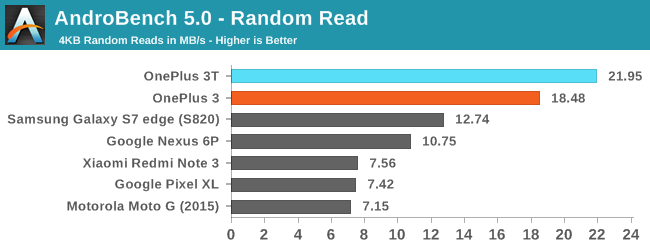
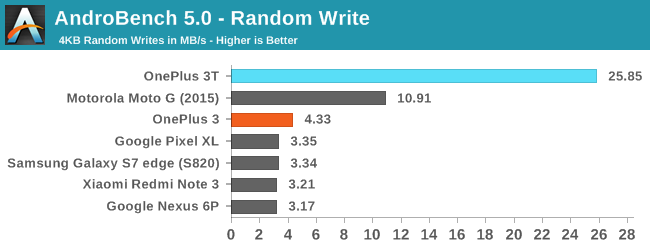
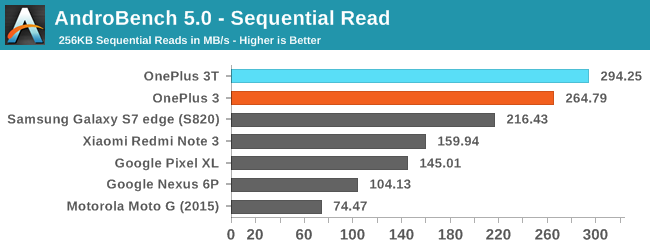
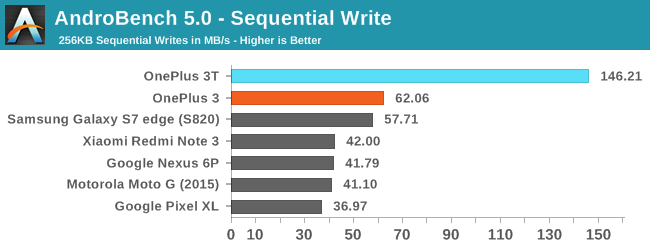
In Androbench 5 the OnePlus 3T tops the charts. However, it's important to recognize why this is, particularly where write speeds are concerned. Most smartphones we review have either 16GB or 32GB of internal memory. The OnePlus 3 has 64GB, and this OnePlus 3T unit is the flagship 128GB model. With flash memory, assuming that you have some density for a chip, increasing capacity is accomplished by increasing the number of chips. Because SSDs and other flash memory devices utilize parallel writes to improve performance, increasing the number of dies can allow for greater performance by increasing the number of writes that can happen in parallel.
In addition to the larger amount of internal storage, OnePlus has also adopted F2FS for the filesystem, which is another source of performance improvements, particularly in the case of random write speeds.
With that in mind, the results from AndroBench actually aren't that shocking. In the write tests the 128GB model of the OnePlus 3T is well ahead of every other device, including the 64GB OnePlus 3. Read performance is also improved compared to the OnePlus 3, but not to the same extent.










104 Comments
View All Comments
arayoflight - Tuesday, November 29, 2016 - link
Do you have any proof it's using UFS 2.1. Looks like regular UFS 2.0 with F2FS filesystem to me.To confirm that, I installed androbench on my Oneplus 3, set the parameters to what Anandtech uses(256 KB read for seq, 4KB for random and 1 I/O thread).
Since my Oneplus 3 is running on F2FS too(OxygenOS 3.5.6 has it by default)
Here are the results I got:
Random Read: 21.35 MB/s
Random Write: 25.21 MB/s
Seq read: 264.23 MB/s
Seq write: 140.4 MB/s
These are almost exactly equal to the results from the 3T in the review. Hence, I think they are not using UFS 2.1 on the 3T.
Meteor2 - Tuesday, November 29, 2016 - link
Indeed, I see no suggestion that UFS 2.1 is being used in the 3T.andrewaggb - Monday, November 28, 2016 - link
My top 3 for a smartphone are screen, cameras, battery life. This upgrade improves on 2 of them.mgl888 - Monday, November 28, 2016 - link
I wish the review tested the new front facing camera.boeush - Monday, November 28, 2016 - link
I agree with Brandon on the camera aspect: it would have been valuable to upgrade the rear camera; the front camera upgrade isn't really worth the money if the older model was already good-enough.Mr Perfect - Monday, November 28, 2016 - link
OnePlus gets a lot of love these days. I'd consider one, but the OS updating is a little hazy. What are the community builds people talk about? Does OnePlus make a release version, then open source it to the community to maintain? Are they talking about Nougat in any way?I was hoping they'd become the new Nexus, but it looks like they're not there yet.
JoeyJoJo123 - Monday, November 28, 2016 - link
CyanogenMod supports OnePlus phones, and I'm sure OnePlus 3T will come very soon.If it's any reconciliation, my Nexus 4 is on CyanogenMod 13 (Android 6.0 - Marshmallow) even though Google chose to end support for the Nexus 4 before Marshmallow even came to the Nexus 4.
JoeyJoJo123 - Monday, November 28, 2016 - link
Additionally:https://en.wikipedia.org/wiki/CyanogenMod#Cyanogen...
"The first experimental build of Cyanogenmod 14.1 based on Android 7.1 was released for Oneplus 3 device..."
So even though OnePlus themselves haven't released a Nougat equivalent of OxygenOS, yet, CyanogenMod's been on the ball, and even sourced their newest OS to the OnePlus 3 first.
There's really 3 major brands of phones that Cyanogenmod tends to support well today: Motorola, Samsung, and LG. Of those, only Motorola sometimes comes with an unlocked bootloader and root access. OnePlus phones come with that standard, as is usual with Nexus phones.
In many ways, OnePlus supplanted the Nexus line. Alternatively there's a few Motorola phones that come with unlocked bootloaders (and are marketed as Developer editions), etc.
Mr Perfect - Monday, November 28, 2016 - link
Good info, thanks. I was hoping OnePlus would be an all-in-one hardware and software solution like Nexus was, but throwing CyanogenMod on solid hardware is the next best thing.UtilityMax - Wednesday, November 30, 2016 - link
I don't get the obsession about frequent updates. To my humble eye, Lollipop, Marshmallow, and Nougat look almost the same. Nougat barely adds anything new, and Marshmallow was viewed as a bug-fix release to Lollipop. The Nexus device users were the first one to receive Nougat, but the sad reality is that Google is using them as beta testers.Regarding, Oneplus updates, based on my experience with Oneplus One, I think Oneplus updates were pretty honest. The device came out with KitKat, then got updated to Lollipop (after a lengthy delay), and then to Marshmallow. Not bad for a device that shipped with KitKat. My Samsung tablet got the same treatment, but a lot slower than Oneplus One.